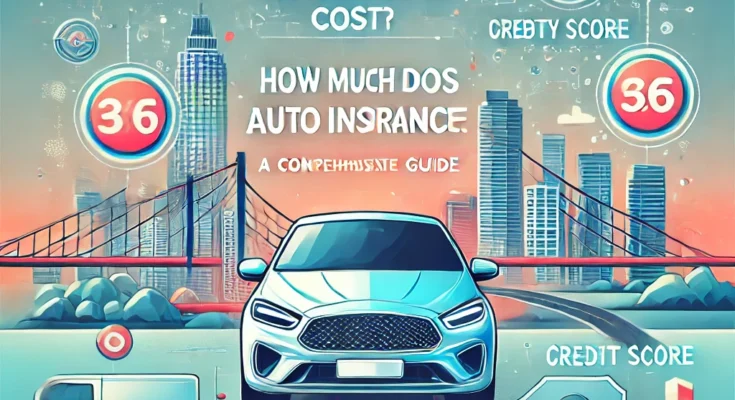Auto insurance is an essential expense for drivers, but the cost can vary widely depending on several factors. If you’ve ever wondered, “How much does auto insurance cost?” you’re not alone. This comprehensive guide will help you understand what determines the cost of auto insurance and how you can potentially save money.
Understanding the Basics of Auto Insurance Costs
The cost of auto insurance varies widely based on several factors. On average, U.S. drivers pay around $1,200 to $1,500 per year for full coverage, but your specific rate may differ. Let’s break down the key factors:
1. Location
Where you live plays a significant role in determining your auto insurance premiums. States with high traffic density, theft rates, or natural disasters often have higher insurance costs.
2. Driving Record
Your history as a driver is critical. A clean driving record typically results in lower premiums, while accidents, tickets, or DUIs can increase your costs.
3. Vehicle Type
The make, model, and year of your car influence your insurance rate. Luxury cars, sports cars, and vehicles with high repair costs generally have higher premiums.
4. Coverage Levels
The type and amount of coverage you choose will directly affect your costs. Full coverage—which includes liability, collision, and comprehensive insurance—costs more than minimum liability coverage.
5. Demographic Factors
Age, gender, marital status, and even credit score can impact your auto insurance premiums. For example, younger drivers often pay more due to their limited driving experience.
Other Factors Influencing Costs
While averages are helpful, auto insurance costs are personalized. Companies consider a wide range of variables, including:
- Vehicle Type: Insuring a luxury car is costlier than a standard sedan.
- Driving Record: A history of accidents or violations raises premiums.
- Credit Score: In many states, a good credit score helps reduce costs.
How to Use This Information
Understanding these factors allows you to estimate your auto insurance costs and identify ways to lower them. By shopping around and tailoring your coverage to your needs, you can find a plan that fits your budget.
So, how much does auto insurance cost for you? It depends on your circumstances, but knowing the averages and influencing factors puts you in a better position to make informed decisions.
Average Auto Insurance Costs in the U.S.
When asking, “How much does auto insurance cost?” it helps to understand the national averages. Here’s a detailed breakdown of average annual costs based on different factors:
By Coverage Type
- Minimum Liability Coverage: $600 – $800 per year
- Full Coverage (Liability, Collision, and Comprehensive): $1,200 – $1,500 per year
By Age Group
- Teen Drivers (16-19 years): $3,000 – $5,000 per year (full coverage)
- Young Adults (20-25 years): $1,800 – $2,500 per year
- Adults (26-65 years): $1,200 – $1,500 per year
- Seniors (65+ years): $1,300 – $1,800 per year
By State
Insurance costs vary significantly by state due to regulations, risk levels, and population density:
- Most Expensive States: Michigan, Louisiana, and Florida often rank highest, with premiums exceeding $2,500 per year.
- Least Expensive States: Vermont, Maine, and Ohio have average premiums around $800 – $1,000 per year.
Factors That Affect the Average Costs
When asking, “How much does auto insurance cost?” it’s important to understand the specific factors that influence the average cost. These factors not only determine your rates but also highlight areas where you might be able to save money. Let’s take a closer look:
1. Driving History
Your driving record is one of the most critical factors influencing your auto insurance costs. If you have a history of accidents, traffic violations, or DUIs, insurers will consider you a high-risk driver and charge higher premiums. On the other hand, a clean driving record with no violations can help you secure discounts and lower rates. Many insurers also offer safe driver programs, which reward you for maintaining a spotless record over time.
2. Age and Experience
Age and driving experience are key determinants of your auto insurance rates. Younger drivers, particularly those under the age of 25, typically face higher premiums because they are statistically more likely to be involved in accidents. As you gain experience and move into older age brackets, your premiums may decrease. However, older drivers, particularly those over 70, may see an increase in costs due to potential health-related risks.
3. Vehicle Make, Model, and Year
The type of car you drive can significantly impact how much your auto insurance costs. Luxury vehicles, sports cars, and cars with high-performance engines generally come with higher premiums due to their expensive repair costs and increased risk of theft. On the other hand, cars with high safety ratings, anti-theft devices, and low repair costs can help lower your insurance rates. Additionally, newer cars often cost more to insure than older vehicles, although this can vary depending on the vehicle’s safety features.
4. Location
Where you live affects your insurance premiums more than you might realize. Urban areas typically have higher rates due to increased traffic, higher crime rates, and a greater likelihood of accidents. Conversely, rural areas often see lower premiums because of reduced traffic and lower crime rates. Your state’s regulations and minimum coverage requirements also play a role. For instance, states prone to natural disasters like hurricanes or floods might have higher average insurance costs.
5. Credit Score
In many states, credit score is an important factor in determining auto insurance costs. Insurers use your credit score as an indicator of financial responsibility, which they correlate with the likelihood of filing claims. A high credit score can result in lower premiums, while a poor credit score might lead to higher rates. It’s essential to maintain good credit habits, such as paying bills on time and reducing debt, to keep your insurance costs manageable.
6. Coverage Type and Limits
The level of coverage you select has a direct impact on your premium. Minimum liability coverage is typically the cheapest option but provides the least amount of protection. Full coverage policies, which include liability, collision, and comprehensive insurance, offer broader protection but come at a higher cost. Additionally, selecting higher coverage limits or lower deductibles can increase your premium. Customizing your coverage to suit your needs is essential to balancing protection and affordability.
7. Annual Mileage
How much you drive each year affects your insurance rates. Insurers consider frequent drivers at higher risk for accidents, leading to increased premiums. If you’re a low-mileage driver, you may qualify for discounts or specialized pay-per-mile insurance programs. It’s a good idea to accurately report your mileage to your insurer to avoid overpaying.
8. Safety Features and Anti-Theft Devices
Cars equipped with advanced safety features and anti-theft devices can lower your auto insurance costs. Features like airbags, anti-lock brakes, lane departure warnings, and automatic emergency braking reduce the likelihood of accidents and injuries, making them attractive to insurers. Similarly, anti-theft devices like alarms, GPS tracking, and immobilizers can reduce the risk of theft, leading to potential discounts.
9. Marital Status
Marital status can also influence your auto insurance premiums. Statistically, married individuals are less likely to be involved in accidents compared to single drivers. As a result, some insurers offer lower rates to married policyholders. If you’ve recently tied the knot, notify your insurer to see if you qualify for a discount.
10. Insurance History
Your insurance history, including any lapses in coverage, can affect your premiums. Continuous coverage demonstrates responsibility and reliability, while gaps in coverage may indicate risk to insurers. Maintaining consistent insurance coverage, even during periods when you’re not driving frequently, can help keep your rates competitive.
Average Auto Insurance Costs in the U.S.
Below is a breakdown of average annual costs based on coverage type:
- Minimum Liability Coverage: $600 – $800
- Full Coverage: $1,200 – $1,500
These rates are influenced by state regulations, so you may see variations depending on where you live.
How to Save Money on Auto Insurance
While auto insurance is a necessity, there are several ways to reduce your premiums without sacrificing coverage:
1. Compare Quotes
Shop around and get quotes from multiple insurers. Online comparison tools can make this process quick and easy.
2. Bundle Policies
Consider bundling your auto insurance with other policies, such as home or renters insurance, for discounts.
3. Maintain a Clean Driving Record
Avoid accidents and traffic violations to keep your premiums low. Some insurers offer discounts for safe driving.
4. Choose a Higher Deductible
Opting for a higher deductible can lower your premium. Just ensure you can afford the out-of-pocket costs if you need to file a claim.
5. Ask About Discounts
Many insurers offer discounts for students, military members, or low-mileage drivers. Ask about all available discounts to maximize savings.
conclusion
Understanding the question, “How much does auto insurance cost?” is key to managing your expenses effectively. Your auto insurance premiums depend on a wide range of factors, from your driving history and location to your vehicle type and coverage needs. By considering these factors and shopping around for the best rates, you can find a policy that fits your budget and lifestyle.
Remember, auto insurance isn’t just a legal requirement in most places—it’s also a vital safety net that protects you financially in the event of an accident or unexpected event. Take the time to research, compare options, and ask questions to ensure you’re getting the coverage you need at a price you can afford.


